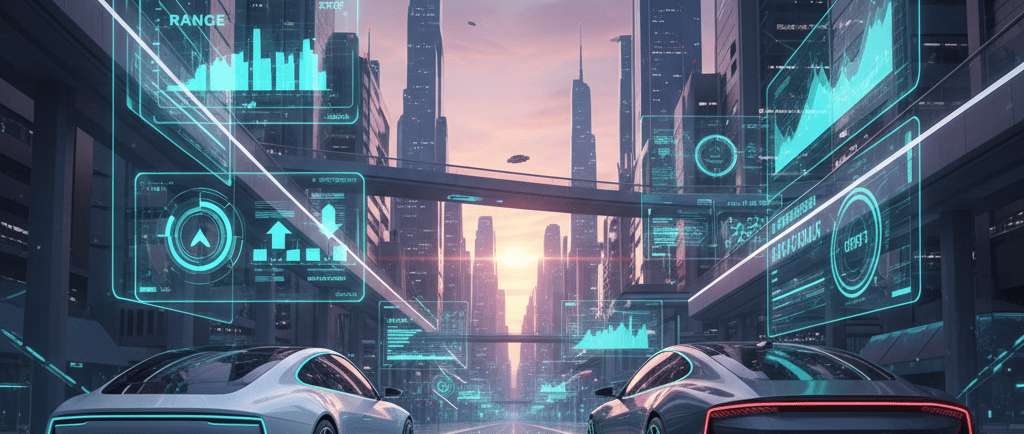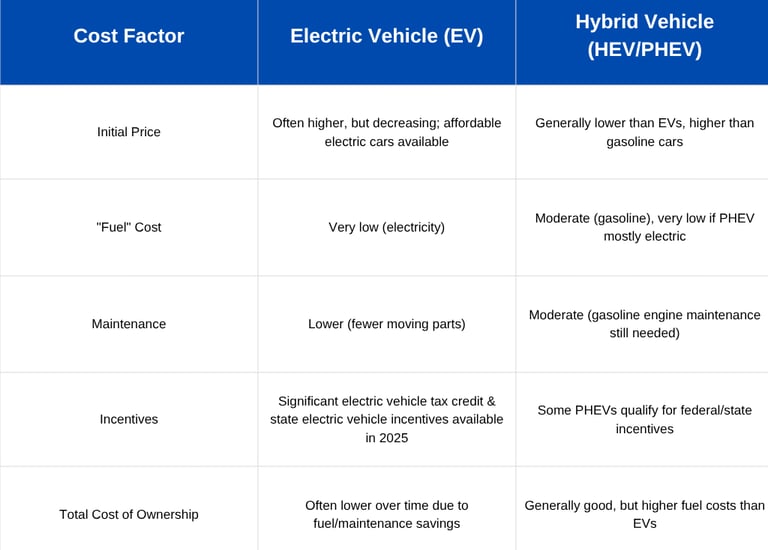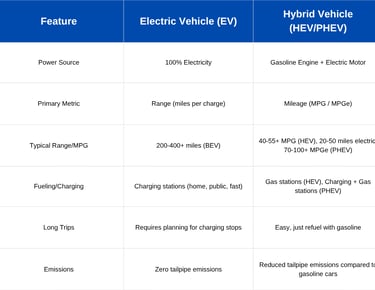Electric Vehicle vs Hybrid Vehicle: Full 2025 Comparison
BIT WISE REVIEWS
10/10/2025


It is almost as though one may be walking in a maze when it comes to choosing a new car these days, with all the exciting new technologies present in cars of 2025. The friendly alternatives to gas-guzzlers that have gained popularity among all car drivers are hybrid automobiles and electric vehicles (EVs). They both offer more efficient, often cleaner ways of getting around, though in highly different ways.
This is a comprehensive guide that will break down everything one needs to know about electric and hybrid cars, featuring a range, miles per gallon, and prices against each other in comparison. Be it a technological enthusiast looking to get fed on the next big thing or a simple consumer in search of valid buying suggestions, the variance between the two plays a critical role in helping them choose the best one that fits their lifestyle. Well, it is time to dive in and see what really motivates the future of driving for you.
Key Takeaways
EVs work with electricity and alone, which makes their tailpipe emissions zero, provides instantaneous torque, and lowers fuel costs. They are generally expensive to install initially and require a charge.
Hybrid Vehicles are equipped with a gasoline motor and an electric motor. Traditional types of Hybrids increase fuel mileage with plug-in hybrids (PHEVs) offering a few miles of all-electric range before charge, switching to gasoline, reducing the necessity of public charging.
All is different with Range & Mileage: EVs should be used in domains of day-to-day commuting with home charge, whereas hybrids should be applied in areas of long-distance traveling with no range anxiety.
Pricing involves more than the price tag. EVs can receive an electric vehicle tax credit and electric vehicle incentives in 2025, which alleviates the operating and maintenance costs, despite their higher cost of initial purchase than hybrids.
Your Best Choice is defined by your driving style, availability of charge, and your budget, as well as environmental issues. The two technologies have rapidly evolved, which has seen affordable hybrid cars and highly efficient hybrids becoming cheap to come by.
Knowing the Natives: What Do We Compare?
It is important to define what an electric vehicle and a hybrid vehicle are before we get down to the details. The first step to telling which of the two is most suitable for you is knowing their basic differences.
Electric Vehicles (EVs) ⚡
An electric car, or simply EV, is an electric-powered car. Instead of using a gasoline-powered internal combustion engine (ICE), an electric motor is used on the EV to power the vehicle with a large battery pack. The process of charging an EV is similar to charging your smartphone or laptop, i.e., you plug it into an electric source.
There are a few kinds of EVs:
Battery Electric Vehicles (BEVs): This is easily the most common type of EV. They do not have an internal combustion engine at all, and instead, they rely on their battery as the power source. Well-known models used by Tesla, Ford, Hyundai, and Kia can be used as examples.
Fuel Cell Electric Vehicles (FCEVs): These produce electricity by utilizing hydrogen gas in a fuel cell. Though they are emitting nothing, there exist very limited hydrogen fueling stations throughout the majority of areas.
Among the main characteristics are missing tailpipe emissions. They do not emit any exhaust gases on the road, thus fitting well in the air quality.
Hybrid Vehicles (HEVs & PHEVs) ⛽
A hybrid car contains two or more sources of power. This would almost always be a gasoline-powered car with an electric motor and a smaller battery. A hybrid is meant to assist the gasoline engine with the help of the electric motor, thereby making the car more fuel-efficient.
There is also a hybrid of different types:
Standard Hybrids (HEVs): They are the first generation. They can't be recharged. The gasoline motor drives the battery and the electric motor (generates energy when you brake) when you are not braking. They automatically alternate between electricity power, gasoline power, or a combination of both to optimize fuel consumption. They are very low-speed,all-electric range.
Plug-in Hybrid Electric Vehicles (PHEVs): This is a hybrid type that is between the standard hybrids and full EVs. PHEVs possess a larger battery in comparison to traditional hybrids, and can be charged up by plugging into an electrical socket. When this is achieved, they are able to travel a long distance (typically 20-50 miles) by using only the electric power before handing over to the gasoline engine. After the electric range is exhausted, they operate like a conventional hybrid.
Major Characteristic: They have increased mileage over gasoline-only cars, and their independence from gasoline during long road journeys, because they can find a station to charge their cars.
Distance / Coverage: Going the Distance
It is possible that one of the most significant aspects of choosing between an EV and a hybrid is the distance covered and its energy consumption rate. Here, the range (in EVs) and the performance (in hybrids) come into perspective.
Electric Vehicle Range: Range of Electric Vehicles.
The Range of an electric vehicle is the approximate range over which the electric vehicle will move with a single charge. New EVs with impressive ranges appear in 2025.
These are the factors that affect range:
Battery Size: The larger the battery, generally, the larger the range.
Driving Style: Hard acceleration/braking, high speeds, and aggressive driving are the factors that reduce the range.
Weather: EV range is affected by cold weather to a large extent, with battery efficiency dropping, and energy spent on warming up the cabin. There is also the effect of hot weather on range.
Terrain: Uphill driving is energy-consuming.
Accessories: There are air conditioning, heating, and other electronics, which use the battery power.
Range Anxiety: Fearing that the EV will run out of power even before it reaches a charging station. Though the number of public charging facilities is growing rapidly in 2025, it is worth considering for the long routes.
An EV has a range that is sufficient for most everyday motorists. Americans do not drive more than 40 miles per day, and thus home charging will be the difference-maker.
Hybrid Miles per Hour: Fuel Economy and Total Range.
In the case of a hybrid, mileage would typically refer to its gas efficiency, in miles per gallon (MPG) or miles per gallon equivalent (MPGe) in the case of PHEVs.
Non-Plug-in Hybrids (HEVs): This category of cars provides a company with a huge fuel-mile boost in comparison to their gasoline-only competitors. Hybrid Electric Most non-plug-in hybrids are estimated to achieve 40s or 50s combined MPG. They have the same overall range as a gasoline vehicle, as they can be refueled at any gas pump.
Plug-in Hybrids (PHEVs): PHEVs are equipped with two ranges, widely known as an electric range (typically 20-50 miles) and a combined gasoline mile per gallon (MPG) after the battery has been depleted. They typically achieve a higher MPGe efficiency of more than 70-100% of pure electricity. They are a standard hybrid, with acceptable gasoline MPG, once the electric range is exhausted. Their electric and gasoline range is typically very great, up to 500 miles or more.
Major strength: Lacks range anxiety. There is always the option of using the gasoline engine in case you can not find a charging station or make rather long trips.
Table of Comparison of Range and Mileage




Read more: Smart indoor gardening solutions with AI-powered planters
Driving Experience and Performance.
EVs and hybrids also do not drive the same way, besides their distance range.
Electric Vehicle Performance: Instant Thrills, Quiet Ride.
Instant torque is one of the most suggestive aspects of an electric-powered car. Electric vehicles deliver full load at zero speed, thus accelerating with a high dignity, thus shocking first-time electric vehicle drivers. This has given them an appearance of being zippy and snappy, especially within town.
Unbumpy and Hushpuppies: EVs are highly unbumpy and smooth since they do not have a gas engine. Engine vibrations, gear changing, and noise are imposed, hence, a peaceful drive.
Handling: The huge battery pack is normally placed low in the chassis, thus assisting in keeping the centre of gravity low. This is likely to endow good handling and stability.
Regenerative Braking: EVs also employ regenerative braking. In this system, the electric motor acts as a generator during the deceleration process, as the electric motor recovers this energy and the energy is directed back into the battery. This allows one-pedal operation in some models, such that one removes their foot from the accelerator and the vehicle dramatically slows down.
Hybrid Performance: Miraculous Transitions, Standardized Force.
EVs have an advantage because of the driving experience offered by hybrid vehicles, which bridges the gap between traditional gasoline-powered vehicles and EVs.
Smooth Transitions: It has been reported that modern hybrids have served well when it comes to switching between electric power and gasoline power, and both seamlessly. You can barely notice the engine being turned on or off.
Light at Low Speeds: The majority of hybrids are capable of running on electric power at low speeds, which contributes to silence in parking lots and at a standstill traffic.
Comfortable Drive: Hybrids are also easier to drive compared to electric cars, and the reassuring presence of a gas engine will be experienced for a longer time and on a long-range basis.
PHEV Benefit: Since plug-in hybrids can deliver an authentic electric driving adventure on the way to work, only to switch to the rest of the hybrid capability on the way to work, these hybrids will provide drivers with the best of both worlds.
Labor, Sales, and Classic Expenses
Money is a good factor when deciding to invest in an EV or a hybrid vehicle. This includes the initial purchase price, the maintenance fees, and the recurring items of fuel prices.
Original Purchase Price: Can Electric Cars Be Affordable in 2025?
Historically, EVs have been priced higher than either the gas or hybrid versions at the sticker price. The gap, however, is narrowing very fast in 2025.
Electric Vehicle: Although a few high-end EVs continue to be pricey, the market for low-cost electric cars has expanded immensely. The majority of new EVs offered by mass-market manufacturers have become more affordably priced than mid-to-high-end gas or hybrid cars, especially with incentives.
Hybrid Vehicle: Hybrids are typically more expensive than their gasoline-only counterparts, but in many ways cheaper than most of the pure EVs in the initial purchase. Compared to regular hybrids, PHEVs tend to be more costly due to the cost of large batteries that can be plugged in.
Fuel /Externality Costs: Electricity vs. Gasoline.
That is where EVs would be California Dreamin' when it involves saving money.
Electric Vehicle: It is significantly cheaper per mile to charge an EV at home, especially during a non-peak period, as opposed to purchasing gasoline. The price will specifically depend on your local electricity charges; however, it is generally comparable to that of $1-2 that you pay for a gallon of gas. In most cases, even public charging, especially DC fast charging, might be more expensive, but even in that case, it is commonly lower than gasoline.
Hybrid Vehicle: Hybrids are cheaper to operate than conventional vehicles, but you are spending on gas anyway. It would cost you a certain number of miles based on the cost of gas and on the MPG of your car. PHEVs are neither nor both, keeping your range in your electric charge, and recharging, so you never have to spend much on gas.
Maintenance: Reduce the Number of Moving Parts.
Electric Vehicle: EVs have a much smaller number of moving parts compared to gasoline motors (there are no spark plugs, no oil changes, no timing belts, etc.). This is usually translated to low basic maintenance costs. Though the effect of regenerative braking may also reduce brake wear.
Hybrid Vehicle: Hybrids do not lose a gasoline engine; therefore, they require standard engine care (oil change, replacement of the filter). However, the electric motor has the potential to reduce the amount of wear and tear on the gasoline engine and generate a longer life on brake pads by using the technology of regenerative braking.
Tax Credit and Incentives on Electric Vehicles in 2025.
Among the most captivating aspects of buying an EV or a PHEV in 2025, government subsidies will also be on offer.
Federal Tax Credits: Approved new clean vehicles can also receive a federal electric vehicle tax credit in the form of a credit of $7,500 provided by the U.S. federal government. This will see changes made to the credits, enabling the credit itself to be contested at the point of purchase; it will become an immediate discount, not a tax refund in the future.
State and Local Incentives: Electric vehicle incentives, such as rebates, tax breaks, or free charging or special parking, are offered by many cities, states, and electric utility companies. These assist in reducing the real cost of acquisition of an EV or PHEV significantly.
Used EV Credits: Federal tax credits are also applicable to used EVs, which lowers the cost of the affordable electric cars even further.
The point is that the Federal tax credits combined with local incentives can estimate the actual price of an EV possession as inconceivably competitive as compared to some more conservative gasoline-powered cars.
Total Cost of Ownership (TCO)Once your calculations are completed to estimate the cost of purchase (discounting incentives), the cost of fuel (excluding fuel efficiency), plus maintenance, the total cost of ownership becomes more and more costly than that of similar models operating on a hybrid or gasoline power system. It is one of the primary considerations for many consumers, especially those mindful of the cost of electric cars.
Cost Comparison Table
Read more: Robotic Pool Cleaners for Automated Home Maintenance
Environmental Impact
The third-best reason for getting an EV or hybrid is the environmental benefits, which are of greatest importance to most.
Electric Vehicles EVs do not have tailpipe emissions. This improves air quality in the area, especially in urban areas. Electricity production has a decisive effect on the general environmental footprint. The less carbon-intensive and the cleaner the EV energy becomes with more renewable energy sources (solar, wind) used to generate electricity, the more intense the well-to-wheel emissions brought about by the technology.
Hybrid Cars: Hybrids reduce tailpipe emission levels in comparison to typical gasoline-powered vehicles due to their superior fuel efficiency and their ability to run at times on electricity. They are still using fossil fuels, but in a better way, thus with a lower carbon footprint. Even greater beneficial effects are offered by PHEVs, especially in cases when they are charged regularly and driven using electricity.
California: Travel Easy to Charge and Refuel?
And the manner in which you gas up your automobile and the location you select is another key difference.
EV Charging: A New Habit
Home Charging (Level 1 & 2):
Most owners of EVs charge at home
Level 1: It connects to the 120 V house receptacle. It is slow (gains range 2-5 miles per hour) yet convenient when it comes to overnight drip charging.
Level 2 Level 2 requires a 240 V outlet (e.g., clothes dryer) and a free-standing charger (EVSE). Far faster (gains 20-30 miles/hour) and is able to charge most EVs fully at night.
Level 2 (Public Convenience Charging):= DC Fast Charging:
Level 2: On those shopping malls and public parking lots in the workplace. Adequate to fuel up when you are parked.
DC Fast Charging (Level 3): The fastest among the three and generally happens in tighways and megabusiness areas. Charge 20-40 minutes max. Range of 100- 200 miles. The fast charger market is increasing at a rapid rate in 2025.
Charging Time: The giant variant with gasoline cars. It only takes a couple of minutes to refuel a gas car, and hours (at home) or even 2060 minutes (at a fast charger) to charge an EV to 100 percent.
Business as Usual: Hybrid Refueling.
Standard Hybrids (HEVs): Fill fuel at any gas pump like any gasoline-powered car. Takes minutes.
Plug-in Hybrids (PHEVs): A different kind of Hybrid. They have an all-electric range, which they can exploit by charging them at home or at public Level 2 charging stations. You just fill up with gasoline when the battery runs down or when you are on a long road trip. This means that you are now free to not worry that there is never a charger where you need one, when in a Hyper, or where you do not feel that there is an extensive charging system available.
Which One is Best for You?
In the end, the choice of an electric or a hybrid vehicle is up to you, your needs, driving style, and the factor that holds more qualities for you.
Choose an Electric Vehicle when:
You can charge at home: comfort and savings to a large extent are the greatest.
Your daily driving is not too far to the EV: Commutes easily fall into the scope of the current EVs.
You take the environment and clean ride seriously: an EV will offer a smokeless and noise-free ride.
You like to save the operation and maintenance costs: EVs are normally cost-effective with regard to fuel and long-term maintenance.
You like to organize before making longer trips: Longer road trips do require some planning, even though more and more infrastructure is provided to do that.
You would claim electric vehicle incentives and the electric vehicle tax credit in 2025: EVs can become quite affordable.
You are a technology person who likes to adopt new technologies: EVs are at the forefront of car technology. To those who are interested in having the most advanced technology and to futurize their choice, the other future developments of the smartphones could be interesting, like the foldable phones of 2025 or the home robots using AIs to navigate, which could be of interest.
Select a Hybrid Vehicle if:
You often go on long drives down the highway: The range anxiety is removed with the flexibility of gasoline.
You do not have the habitual use of home charging: the standard hybrids do not require plugging in, and the PHEVs offer the use of gasoline as a backup.
You like a higher level of fuel economy, but do not fully devote yourself to an EV: Hybrids can be more fuel-efficient.
You want a reduced first-acquiring cost: Hybrids are relatively cheaper to purchase than a large number of EVs.
You would prefer to reduce your carbon footprint and have the convenience of gasoline: Hybrids are reasonable enough.
You are tech-savvy, though you wish to introduce change a little less abruptly: PHEVs will allow you to drive using electrons, but not fully. It’s a balance similar to the one when it comes to picking a laptop to use in gaming versus cloud gaming. It comes down to finding the right balance that fits your usage habits and familiarity with the new technology.
The Electric and Hybrid Future is Here in 2025 and Beyond.
The car world is changing at lightning speed. In 2025, we are witnessing more options than ever for electric and hybrid vehicles. The technology of batteries continues to improve, and the range of EVs has improved, as well as the charge time. Hybrid technology is also getting finer, with even better gas mileage and seamless transition.
Manufacturers are forced to aggressively pursue greener modes of transportation by government mandates and consumer pressure. Any conversion to EV or hybrid will invest you in a cleaner and technologically adequate tomorrow.
As technology improves, whether through self-driving capabilities in our vehicles or through other gadgets like the Google Pixel Watch 4, which will see wearable computers evolve to cutting-edge technology, the integration of smart technology in our vehicles will just get better. It is nowadays impossible to be informed as a buyer without considering the current benefits, but also the future ones.
Read more: AI-powered Household Robots Transforming Domestic Chores
Conclusion
The issue of electric or hybrid cars is not about which one is necessarily better than the other. It is all about it being the right fit in 2025. EVs offer the ultimate in zero-emission driving, low running costs, and a futuristic experience, especially with the help of electric vehicle tax credits and electric vehicle incentives, making affordable electric cars more common. One of the most niche of such bridges is hybrids, especially plug-in hybrids, with better mileage and lower emissions, but the gasoline comfort everyone is used to.
Consider how you are getting to work every day, access to charging, your wallet, and what you are hoping to achieve as far as the environment is concerned. In case you can, drive the two types of cars to have a feel of what the differences are. But, whatever the case, making the transition to an EV or a hybrid means making the transition to an accelerated, more intelligent, and cleaner manner of driving.
INSIGHTS
Your go-to source for latest tech gadgets news
Support
Connect
© 2025. Bit Wise Reviews
+91 6377810443
Quick Links
